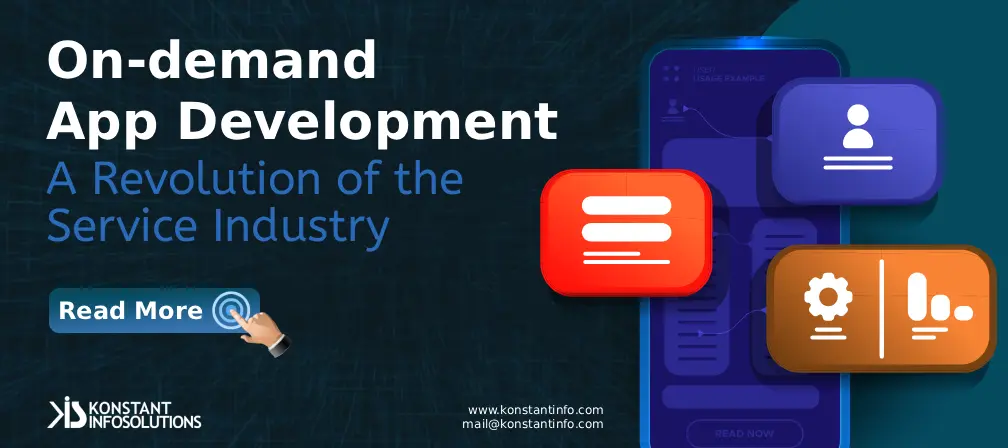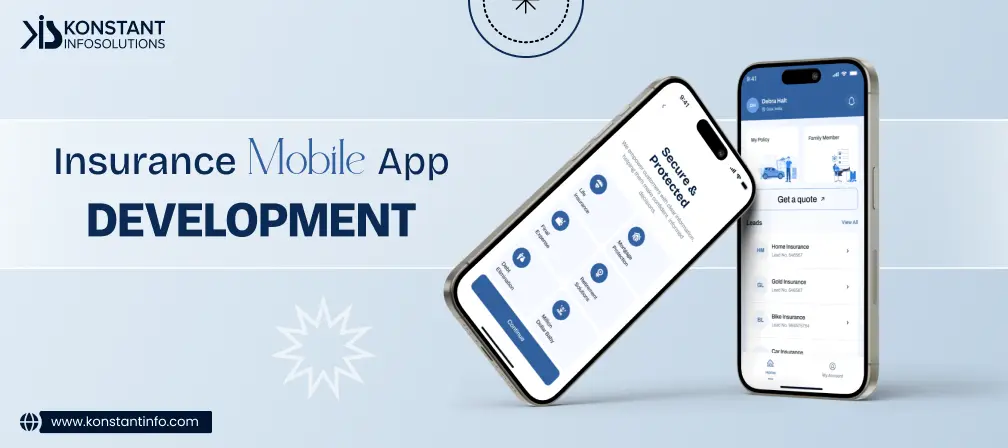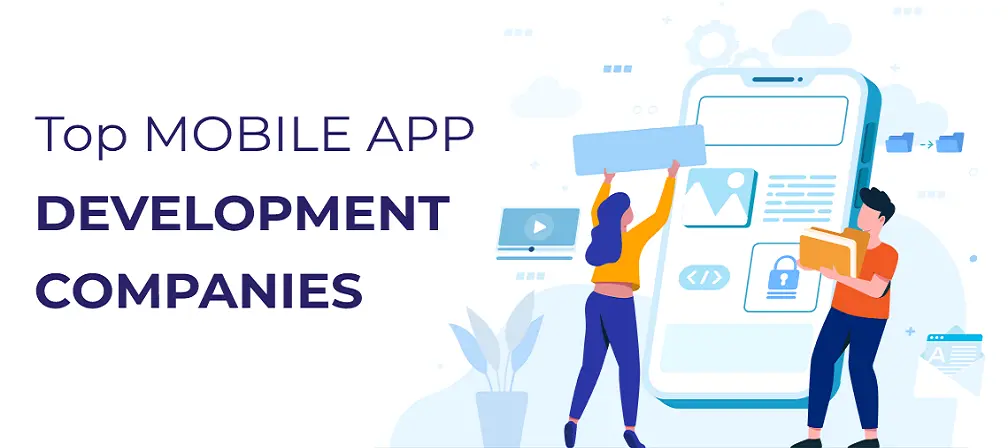
In this fast-paced era of development, starting a new business from scratch has become more challenging. Traditional market practices have evolved into a more scalable, flexible mode.
Thanks to the on-demand economy, businesses are now shifting online by using on-demand app development.
The on-demand market has revolutionized traditional market practices to the point where you no longer need to visit the market to purchase groceries or stand in long queues to book your favorite movie tickets. It has made people’s lives simpler and easier than ever. The On-demand market is estimated to reach $335 billion in 2025. This demonstrates the remarkable growth of the On-demand economy.
Let’s find out what the on-demand app is, how it helps customers, and take a glance at its benefits and features.
On-demand app refers to a web or mobile app which are specifically designed to deliver real-time services based on users’ requests. On-demand applications are scalable, as you
can refine the process by adding additional advanced functions. These apps accept requests for goods and provide on-demand app development services. These apps allow customers to decide whether they want immediate delivery or to set up an appointment for the Dispatch. They create a platform to establish a direct connection between the service provider. In case of any queries, users can easily reach out to the provider.
They cover various sectors such as food and grocery, healthcare, entertainment, transportation, and Beauty among many others. Users can track live location and schedule delivery as per their convenience. With the exceptional delivery services, On-demand applications are becoming more and more indispensable in people’s daily lives.
Growing competition makes it difficult for any business to succeed, but On-demand mobile apps help businesses grow faster and expand their market reach regardless of geographical boundaries. Developing an on-demand mobile app is cost-effective and less time-consuming.
In this blog, we will be exploring every aspect of an on-demand application in detail, including:
Before starting your business journey, it is important to be familiar with the different types of on-demand apps as mentioned below:
Service-based apps, also known as on-demand delivery apps, act as a link that connects users with service providers easily, focusing on instant services like delivering groceries and food, booking tickets, and cabs quickly and effortlessly. These apps save time and effort for both parties (providers and users).
Examples of some popular on-demand service-based apps are:
Product-based on-demand refers to delivering physical products quickly, or usually within a few hours of a request, directly to the user’s doorstep.
Examples: Apps like Instacart, Insta-mart: These usually offer daily groceries like vegetables, bread, and fruits etc for home deliveries.
Bloom Wild: It’s a flower delivery app where users can order fresh flowers.
Rental-based on-demand apps allow users to rent a car rental apps like Turo for bike, car equipment, or luxury cars. It offers cheap options for affordability. It’s an easy way for users to rent various things for a projected period.
Example of Rental-Based On-Demand Application:
Airbnb: Apps like Airbnb is widely popular for connecting travelers with hosts for short-term stays.
Turo: These platforms allow individuals to rent their cars.
Zilok: This platform offers a wide range of products from basic equipment to outdoor gear.
The two most popular on-demand food delivery apps, Swiggy and Zomato. These apps operate 24 hours. They allow foodies to order their favourite dishes from their favourite place instantly.
These apps categorize food options, so user can easily select and order their favourite items. At the same time, these apps save your travel time with their exceptional food delivery apps service.
This is also one of the popular on-demand grocery apps. You don’t have to wake up every morning worrying about going to the market to buy fresh vegetables, fruits, or even flowers etc.
You can get them just with a flick of your finger at your doorstep.
Netflix is one of the most widely remembered video streaming platform. You can easily access unlimited movies, documentaries, and shows by easily subscribing to their plans.
The technological advancement in sensors and unparalleled servers has led companies and startups to install new and updated features in their apps. They can easily compete with their rivals with top features. The following features are fast and effective in providing a personalized user experience.
Let’s take a look at these new advanced features:
The prominent service of the on-demand app is to meet the expectations of customers’ requests. By providing a wide number of options for customers to book services at their convenience, it increases customer satisfaction and retention.
If customers find difficulty deciding on the charges of the goods and services they wish to avail of, on-demand apps allow them to dispel any queries through texting or calling service providers instantly. It also builds trust between customers and service providers.
On-demand app features real-time tracking, helping customers to know about the delivery process and arrival times accurately. Like the location of a delivery driver or a ride.
Payment gateways: We come across several news of incidents in scams daily.
Reliable and secure payment options are vital for any on-demand service. Businesses must have a robust, secure payment method to enable customer payments without any concerns. Another important feature is that it offers payment options in various modes like credit card, debit card, cash, and mobile wallets, etc. So that customers can choose to make payments as per to their needs.
Push notifications have become an easy option to notify users about the trends, new arrivals, live tracking of their products, and promotional offers.
On-demand services apps facilitate the easy exchange of defective products by text or calling service providers directly. This contributes to retaining customers.
There is a saying, “Success demands constant improvement”. This is why customer feedback is critical for on-demand services. This feature allows customer to share their experience about the service by giving ratings or writing reviews. This helps new customers make more wise decisions after reading honest reviews.
An on-demand application must provide a hassle-free cancellation service for customers at their will.
Integration of customer support services in the on-demand application should be mandatory, as it helps to fix queries regarding requested services. This increases loyalty and trust between customers and service providers.
Businesses keep exploring with their on-demand application to expand their market reach and attract customers by offering discounts, coupons, promo codes, and referral codes. It is profitable to both parties. Customers get to save on their desired services, and the companies make a profit too.
A robust search and filter is important for on-demand applications. Search and filter features help customers to quickly and easily find what they are looking for. This enhances customer experience and saves time.
In this fast-paced digital space, startups and companies require 360-degree abilities from their apps. It has become mandatory for developers to build apps that offer a wide range of capabilities. They need to be fast and secure. And overwhelmingly reliable.
Let’s take a look at some of the advanced benefits of on-demand apps:
It’s the main advantage of on-demand applications. It encompasses a variety of sectors like food, groceries, travel, healthcare, banks, education, and e-commerce, among others. Every business gets an opportunity to expand by providing services to customer’s requests with on-demand apps. Businesses can also combine on-demand apps with hubspot lead generation tools to attract and manage potential customers efficiently.
The trend of on-demand applications has increased dramatically over the past few years. In 2021 alone, approximately 230 billion mobile apps were downloaded, and the growth is estimated to be around 7.4 billion mobile users in 2025. Faster services and better convenience have expanded the on-demand application customer base.
Unlike other mobile applications, on-demand application development is cost-effective and provides better solutions than other applications. Businesses can incorporate more functions in one-demand apps to personlise customer experience and engage user engagement without denting their budget.
To stay relevant in the competitive market, constant improvement in the services of on-demand applications is crucial. On-demand apps provide real-time data and feedback, which allows businesses to improve processes and customer experience.
On-demand applications provide better security compared to CMS.
based applications. Consumer’s details like price, wishlist items, payment history, etc., will be fully safe and protected. As the company owns the app, the on-demand app developers can create a safe cloud to keep confidential data in one place.
Another advantage of on-demand applications is that, allow customers to share their experience and feedback about the requested services. It helps to identify weak and poor areas of their services and implement the necessary changes for the future. This fosters a loyal and reliable relationship between customers and the service provider. Positive feedback attracts new customers and boosts engagement.
A well-designed On-demand application is flexible and scalable. A company can easily introduce new features in the app to meet the growing market demand of users. To remain competitive in the market, introducing new and user-friendly features from time to time is crucial.
The cost of developing on-demand depends on various factors, from the developers’ region to dedicated work hours. If a company intends to develop a basic performing app, then it might be cheaper than with advanced, cutting-edge features. In the end, it all depends on the business how much they are willing to spend on the development of the on-demand app. If you want your app to be developed by seasoned and reliable developers, then we will be covering every factor that determines the overall cost of on-demand apps:
Basic or Mid-level apps are cheaper than a full-fledged app infused with advanced features like real-time tracking, chatbots, AI integration, and advanced user interfaces.
If an App is designed for a single platform (IOS or Android), it is going to be expensive than developing cross-platform apps using Flutter and React Native.
Integrating multiple payment methods, mapping services, and delivery logistics, etc., can add to the cost.
Location and time are also important factors that add to the development of on-demand applications. Cost varies from region to region, like Asian developers charge $25 to $45 per hour, and Western developers are estimated to charge around $80 to $90 per hour.
If businesses want their UI/UX to be more interactive, user-friendly, and include a wide range of animations can affect the cost of developing an on-demand app.
In the Beginning, developing an app using MVP (Minimum Viable Product) is budget-friendly than a full-fledged app.
These figures are calculated based on an average developer rate of $50 per hour. All these rates depend on the complexity of the mobile app and the mobile app development agency.
The services app market is reaching success steadily in the last few years. They have become fast. The future of on-demand apps is bright and promising. It’s the right time to expand your business with on-demand apps, as it is cost-effective. Turn your business goals into reality by gaining exposure through on-demand applications. Connect with custom mobile app development company to build such on-demand app.



Manish Jain is the co-founder and Managing Director at Konstant Infosolutions. He is responsible for the overall operations of the company and has played a major role in bringing Konstant up from its humble beginnings and, with his immense energy and drive, transforming it into a globally trusted name in IT solutions.
Or send us an email at: [email protected]